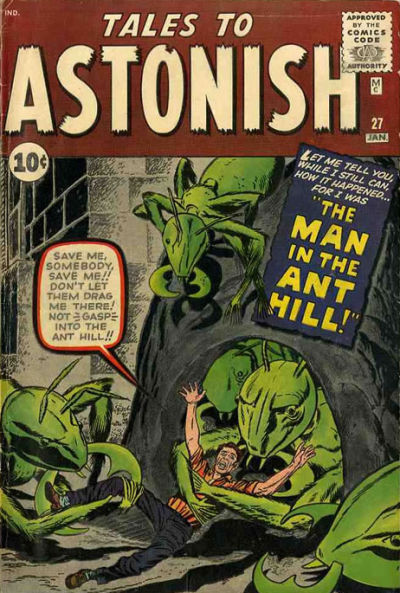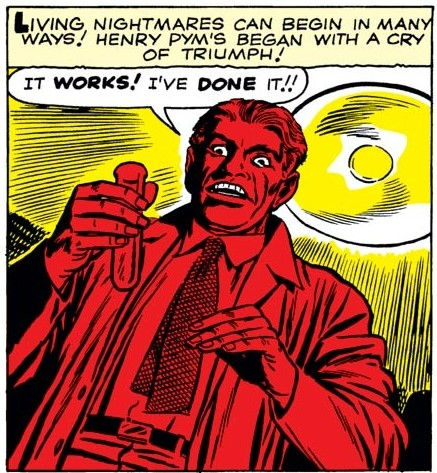The Man in the Ant Hill
- styrofoamturkey
- Feb 15, 2022
- 8 min read
Updated: Mar 13, 2024
Marvel Comics (Tales to Astonish # 27, January 1962)

As I mentioned in my analysis of Fantastic Four # 1, prior to the launch of their Silver Age super heroes, Marvel had been publishing comics in a lot of other genres. They did romance books and western books. Their war and crime books, which had been a staple of their output during the early to mid '50s, had started to fade into the background a bit, their effectiveness, I suspect, blunted by the restrictions of the Comics Code Authority. In place of those, Marvel had opted for releasing a lot of science fiction-themed books, many of which had a bit of a horror bent to them.
These weren't heady, thought-provoking science fiction stories, at least not for the most part. No, these were rapidly produced, pulpy sci-fi tales. That's not meant as a condemnation, just an acknowledgment that there's a difference in style between the kind of science fiction that's trying to tackle larger intellectual issues and the kind that has the goal of thrilling teenage boys. Marvel was going for the latter.
But sometimes, big things can come from humble beginnings and, in the pages of Marvel's Tales to Astonish, one of those pulpy, horror-esque, sci-fi tales would produce a character who would go on to be much bigger. Well, first smaller, then bigger, then back and forth between the two a lot.
Summary
A young scientist named Henry Pym has discovered a serum which can shrink any object, living or not, and another which can return that object to its original size.
Pym is ecstatic, thinking back several months to when he was mocked at a science convention. The other scientists felt that Pym's preference for projects that appealed to his imagination over ones that were practical meant his theories were a waste of time. At the convention, Pym had claimed that his latest invention, which he refused to share, would prove him a better scientist than his colleagues.
Having now completed his size-changing serums (the invention he'd spoken of) and tested them by shrinking a chair and restoring it to its normal size, Pym needs to test it on a living being. In time-honored mad scientist fashion, Pym pours some on himself. Pym shrinks quickly...too quickly, in fact. Reduced to the size of an insect, Pym stumbles out his front door, wondering how he'll ever manage to reach the growth serum up on his window ledge.
Though Pym's voice is now too small for human ears, the ants in his yard hear him and begin to attack him. Pym tries hiding in their ant hill but accidentally falls down an open shaft into a pool of honey. Too his surprise, a single ant comes along and pulls him from the honey, saving him.
Before Pym can escape or figure out the ant's motivation, though, the rest of the ant colony swarms in to attack him again. Pym uses a matchstick that is a part of the ant hill's structure to cause a fire. He manages to climb out of the ant hill, escaping an attacking ant with a judo throw.
Pym spies the growth serum on the window ledge but he has no way to climb up to it and the ants are closing in. Fortunately, Pym sees the same friendly ant who'd saved him before and manages to communicate to it by gesture. The ant lets Pym sit on its back as it climbs up the wall to the window ledge. Once there, Pym leaps into the growth serum and is returned to his normal size.
Pym decides that his serums are too dangerous to be used and destroys them by pouring them down the drain. At the next meeting, Pym announces to the other scientists that his experiment was a failure and never knowingly walks on an ant hill again, for fear of killing the one ant that saved him.
Credits
Writer: Larry Leiber
Penciller: Jack Kirby
Inker: Dick Ayers
Overview
This is pretty standard fair for Marvel's sci-fi fare of the time. It's not particularly better or worse, in my opinion, than any of the other stories they were publishing. It's really the future of the character of Henry Pym that turns this story into more than it is. (Incidentally, Pym is blond in the actual text of the story, not brown-haired like he is on the cover. Such coloring mistakes are far from rare in the '60s.)
Like a lot of Marvel's science fiction tales, the story ignores real science altogether. Shrinking down to that size would effectively make it impossible for Pym to breath. Plus, there's the question of where the additional mass from Pym and the shrunken chair actually goes when they shrink. It's obviously not destroyed, since they can be returned to normal size, so where does it actually go? Oh, and ants don't store honey in their hills.
The screwed up science doesn't really bother me, though, especially the bits around the details of how Pym's process works. The whole idea, after all, is that Pym is supposed to have discovered a way to do something that couldn't otherwise have been done.

What's more entertaining/amusing is Pym's personality. Far from someone who'll eventually end up as a (generally) heroic figure, Pym comes off a bit like a mad scientist. He works in secret and alone. He tests his serum on himself before any sort of trials on non-human lifeforms and without any sort of safeguards. If anything he seems to do it on a whim.
Pym's arguments with the other scientists also seem a bit bizarre. They're arguing that he should stick to practical work while he's insisting that he only wants to work on projects that appeal to his imagination. This seems like a bit of a false dichotomy to me. Many scientists in real life work on things that both appeal to their imagination and have practical uses. The two concepts are not mutually exclusive.
Take Pym's actual invention, the shrinking serum, for instance. It's obviously something that Pym is fascinated with but it's also got immense practical value. Pym even ruminates on the potential ability to move food, supplies and people with ease by shrinking them down and enlarging them upon reaching their destination. Mass production of his serum would revolutionize the world.

But Pym seems less interested in that than he does in simply showing the other scientists that he's their better. There's a distinct element of ego to his personality. While he doesn't come off like a villain, per se, he doesn't seem particularly sympathetic either. When his experiment backfires on him, due to his own carelessness, it feels more like karmic retribution than tragedy.
Marvel's science fiction tales were full of this kind of thing, characters who were too arrogant or selfish getting their ironic comeuppance. If anything, Pym is a relatively mild version of it. He's not that bad a person. He may want to show up his fellow scientists who mocked him but he's not looking to "make the world pay for what it did to him!" or anything like that. This is symbolized by the fact that the story lets him escape the ants in the end, rather than ending on a down note with him getting dragged down into the ant hill to be devoured.
Pym also learns his lesson in the end...errr, sort of. One of the staples of this sort of yarn is for the protagonist to repent their ways and become a better person and this story tries to do that except it's unclear what sort of lesson Pym's supposed to have learned. I mean, if there's a real lesson to be learned from all this it's to have proper safety protocols when experimenting. But the "lesson" Pym seems to have learned at the end is that he was wrong to work on this sort of project in the first place, to destroy his work, to contritely apologize to his fellow scientists (via lying to them and saying his experiment failed) and to...err, never step on an ant hill.
But...
The ability to shrink and enlarge things is a fantastic project to work on. As mentioned above, it would make the world a far better place. There's no reason to apologize to the scientists giving him grief either. The success of this particular experiment has nothing whatsoever to do with whether it was based on practicality or on its appeal to Pym's personality. Experiments fail all the time. The operative factor in their success or failure is the validity of the theory they're based on and the care with which they're carried out, not what motivated the theory in the first place.
As for never stepping on an ant hill for fear of killing that one, friendly ant? It's likely to only live a few more months at most anyway.
And finally, destroying his work? Well, we'll have to see how permanent that turns out to be...
One of the upside of Pym's less-than-perfect personality, though, is how well it fits with some of the issues he'll have in later stories. The man's got issues...
Little Tidbits
-What on Earth possesses Pym to think that the best place to hide from the ants is...in their own ant hill?
-While the honey in the ant hill itself is pretty silly, I do like that, once he falls into it, Pym can't just swim out. He gets stuck as one would in honey.
-The ants having accidentally brought a match stick into their hill as they built it is awfully plot convenient.
-At one point Pym uses a judo throw to toss away an ant that's attacking him. Such a move really shouldn't work, as judo's maneuvers are based on the dynamics and weight distribution of the human body, not the very different ones of an ant. Probably should have just called it "leverage" instead of referencing judo in particular. That said, Silver Age Marvel seems to use judo as their go-to hand-to-hand combat style. It comes up a fair amount.
-Like the Fantastic Four, this story was drawn by the incomparable Jack Kirby, whose art helps it rise above its relatively standard plotting.
-Speaking of the plotting, it appears that was done by Stan Lee but the final script was completed by Lee's brother, Larry Lieber. Larry's a bit of a Marvel mainstay at this point and not without talent himself, not just as a scripter but as an artist too. Nevertheless, I must admit that I don't think he evidences his brother's level of talent for storytelling. His stories are decent, but he lacks the dynamism and unique character focus that his brother brings. I don't groan if I see Larry's name on the page but, honestly, I don't get super excited either.
-We never do get an explanation for the friendly ant that helps Pym escape. There's not one in the story itself and, as far as I know, it's never explained later.
All in all, this was a fun little diversion into what is, at this point, more of Marvel's signature science fiction fare, held over from their Atlas days. But while Pym was getting smaller, the Marvel universe was getting bigger...
Previous Post: The End of the World
Previous Marvel Post: The Fantastic Four
Next Post: The Elasticity of Continuity
Next Marvel Post: The Fantastic Four Meet the Skrulls from Outer Space
Next Henry Pym Post: Return of the Ant-Man
First Marvel Post: Origins of My Love of Marvel
First Post: Stories



Comments